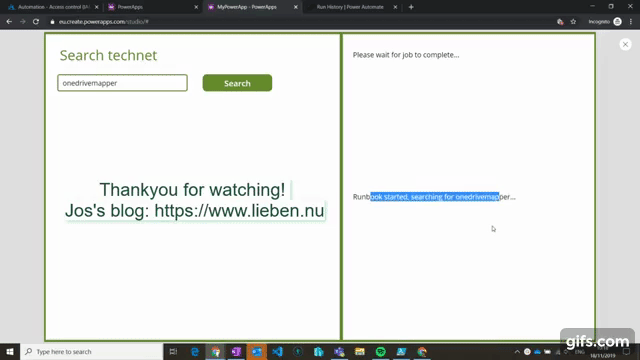As the ‘new’ Graph API does not support application credentials (client_credentials oauth2 flow) when working with most of the ServicePrincipal and Application parts of the Graph API, and I really did not want to work with a user account (background processes, MFA, etc), I had to work something out on some of the older (but still supported) API’s which I gleaned from Msft’s PS modules.
For anyone googling, the following code example allows you to create an azure ad application with serviceprincipal and allows you to modify the manifest of the application (e.g. here is the AppRoles and AppIdentifier).
$tenantId = "75d24247-6221-46a1-a651-530ae36dd399"
$clientId = "62d2235b-2ef6-4d70-b273-401c9eb450b3" #client ID (to call graph api with)
$clientSecret = "xxxxxx" #client secret
[void] [System.Reflection.Assembly]::LoadWithPartialName("System.Web")
$body = @{client_id=$clientId;client_secret=$clientSecret;resource='https://graph.windows.net/';grant_type='client_credentials'}
$headers = @{"Authorization" = "Bearer $((invoke-webrequest -uri "https://login.microsoftonline.com/$tenantId/oauth2/token" `
-Method POST -ContentType "application/x-www-form-urlencoded" -Body $body).Content | convertfrom-json | select access_token -ExpandProperty access_token)"
}
#finding an application or create it if it doesn't exist
$appName = "MyApplication"
$app = (Invoke-RestMethod -Method GET -UseBasicParsing -Uri "https://graph.windows.net/$tenantId/applications?api-version=1.6&`$filter=displayName eq %27$appName%27" -Headers $headers -ContentType "application/json").value
if(!$app){
$body = [pscustomobject]@{
'displayName' = $appName
'availableToOtherTenants' = $True
}
$app = Invoke-RestMethod -Method POST -UseBasicParsing -Uri "https://graph.windows.net/$tenantId/applications?api-version=1.6" -Headers $headers -Body ($body | ConvertTo-Json -Depth 100) -ContentType "application/json"
}
#check/correct the identifier URI of the application's published API
if($app[0].identifierUris -notcontains "api://mydomain/myApi"){
$body = [PSCustomObject]@{
"identifierUris" = @("api://mydomain/myApi")
}
Invoke-RestMethod -Method PATCH -UseBasicParsing -Uri "https://graph.windows.net/$tenantId/applications/$($app[0].objectId)?api-version=1.6" -ContentType "application/json" -Headers $headers -Body ($body | ConvertTo-Json -Depth 100)
}
#check if a certain approle is present, if not, add it
if(@($app[0].appRoles | Where{$_.displayName -eq "Access To My API"}).Count -eq 0){
$body = [PSCustomObject]@{
"appRoles" = @([PSCustomObject]@{
"allowedMemberTypes" = @("Application","User")
"description" = "Access To My API"
"displayName" = "Access To My API"
"id" = [Guid]::NewGuid()
"isEnabled" = $True
"value" = "Api.AccessRead"
}
)
}
Invoke-RestMethod -Method PATCH -UseBasicParsing -Uri "https://graph.windows.net/$tenantId/applications/$($app[0].objectId)?api-version=1.6" -ContentType "application/json" -Headers $headers -Body ($body | ConvertTo-Json -Depth 100)
}
#finding the serviceprincipal belonging to the application or creating it if it doesn't exist
$sp = (Invoke-RestMethod -Method GET -UseBasicParsing -Uri "https://graph.windows.net/$tenantId/servicePrincipals?api-version=1.6&`$filter=displayName eq %27$appName%27" -Headers $headers -ContentType "application/json").value
if(!$sp){
##Adding service principal to application instance
$body = [pscustomobject]@{
'appId' = $app.appId
'tags' = @("WindowsAzureActiveDirectoryIntegratedApp")
}
$sp = Invoke-RestMethod -Method POST -UseBasicParsing -Uri "https://graph.windows.net/$tenantId/servicePrincipals/?api-version=1.6" -Headers $headers -Body ($body | ConvertTo-Json -Depth 100) -ContentType "application/json"
}
Note that, for this code to work, you need to grant your application the Company Administrator role, like this:
Connect-AzureAD
$app = Get-AzureADServicePrincipal -SearchString "myapplication"
$role = Get-AzureADDirectoryRole | Where-Object { $_.DisplayName -eq "Company Administrator" }
Add-AzureADDirectoryRoleMember -ObjectId $role.ObjectId -RefObjectId $app.ObjectId
